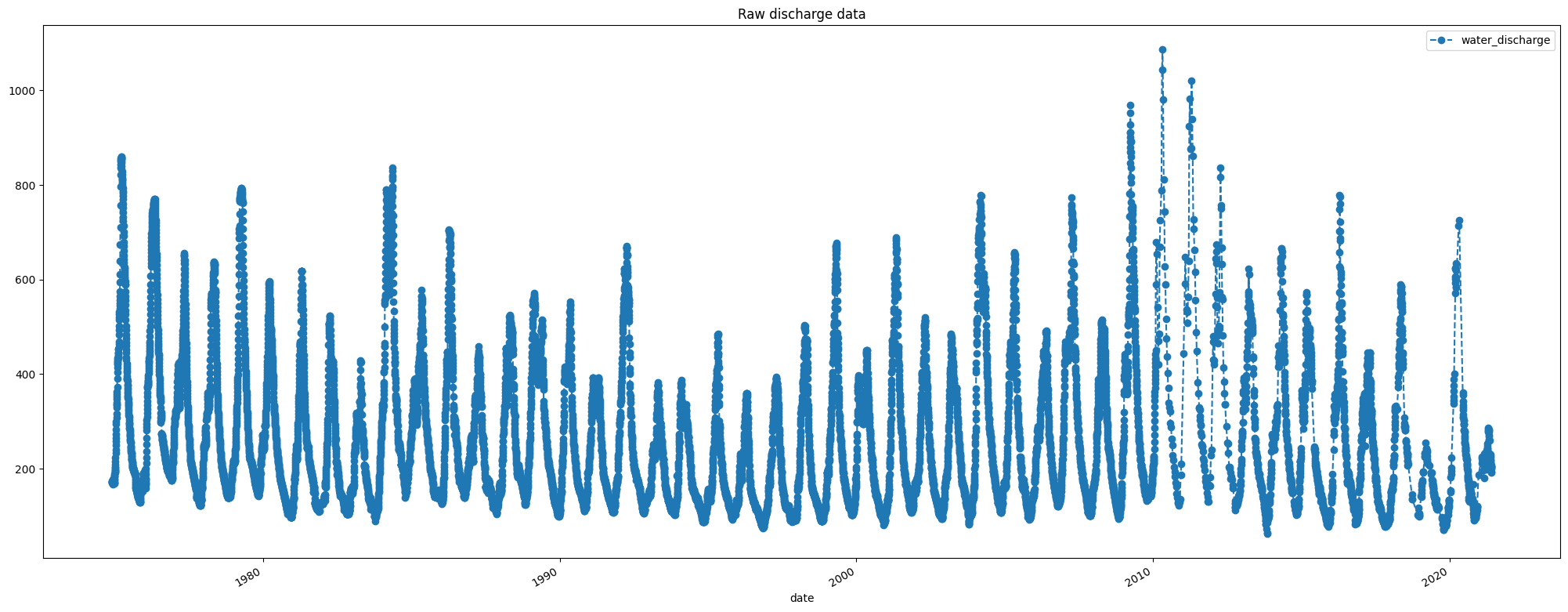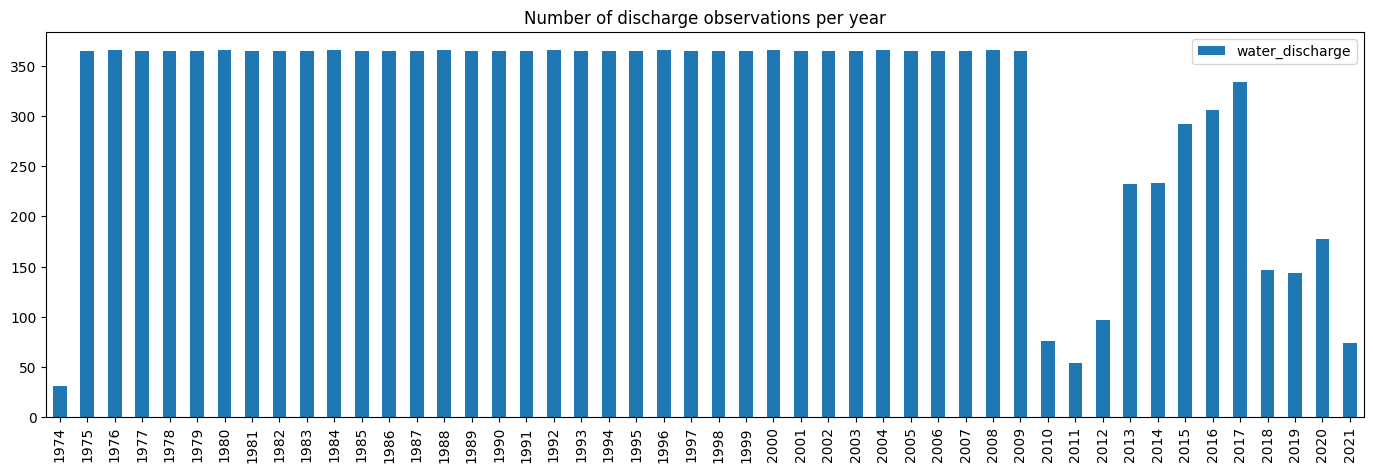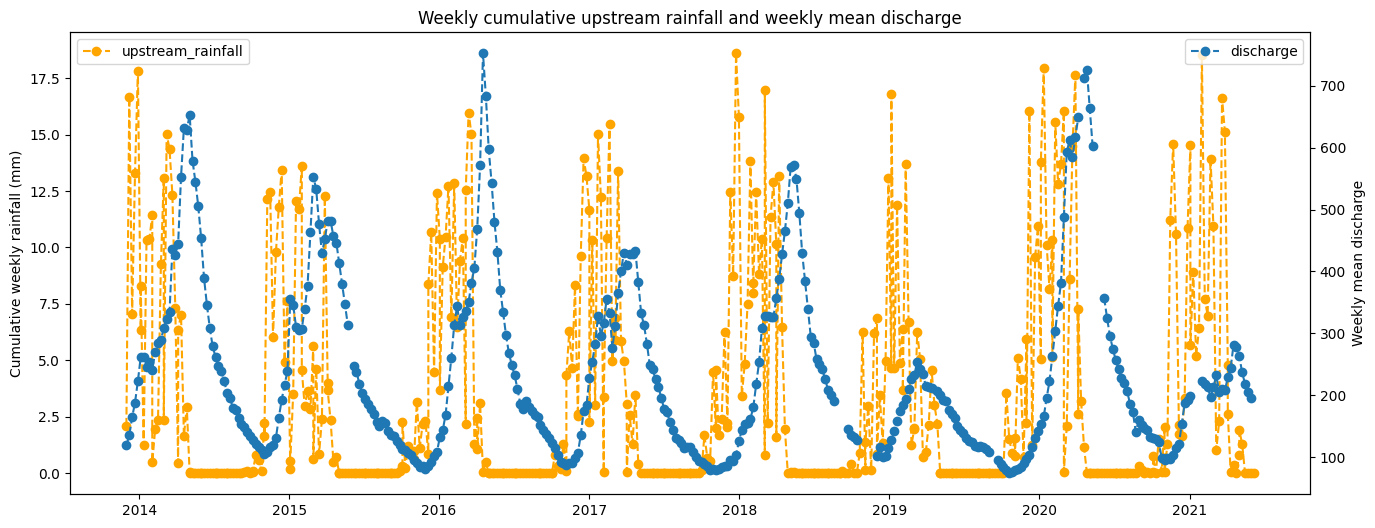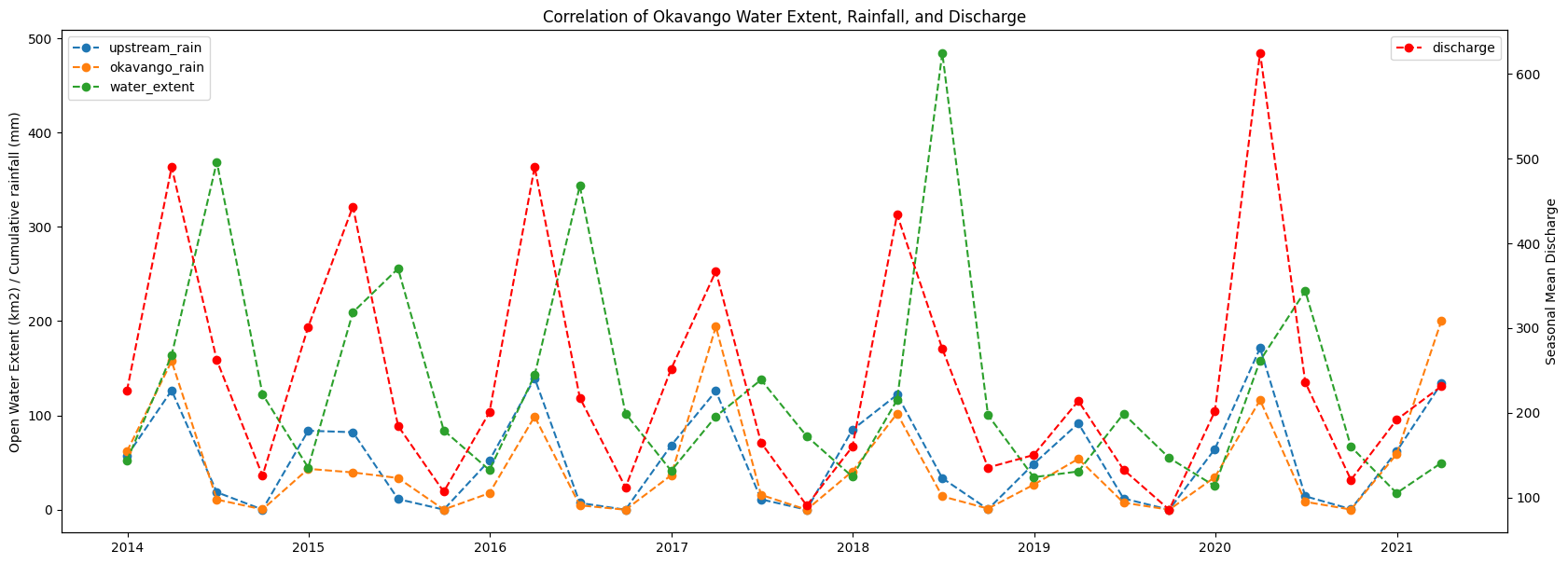Visualising the correlation between rainfall, surface water extent, and discharge¶
Load packages¶
Import Python packages that are used for the analysis.
[1]:
import pandas as pd
import matplotlib.pyplot as plt
from pandas.tseries.frequencies import to_offset
Analysis parameters¶
[2]:
okavango_rainfall='results/okavango_rainfall_2013-12_to_2021-05-31.csv'
upstream_rainfall='results/upstream_rainfall_2013-12_to_2021-05-31.csv'
upstream_rainfall_1W='results/upstream_rainfall_1W_2013-12_to_2021-05-31.csv'
water_extent='results/water_extent_2013-12_to_2021-05.csv'
discharge = 'data/mohembo_daily_water_discharge_data.csv'
Read files¶
[3]:
df=pd.read_csv(okavango_rainfall, index_col='time', parse_dates=True)[0:-1]
upr=pd.read_csv(upstream_rainfall, index_col='time',parse_dates=True)[0:-1]
upr_1W=pd.read_csv(upstream_rainfall_1W, index_col='time',parse_dates=True)
we=pd.read_csv(water_extent, index_col='time',parse_dates=True)
dis=pd.read_csv(discharge)
Process discharge data¶
[4]:
dis['date'] = pd.to_datetime(dis['date'], dayfirst=True)
dis = dis.set_index('date')
Plot the raw data¶
Note the data density of discharge measurements declines in the later years
[5]:
dis.plot(figsize=(25,10), marker='o', linestyle='dashed')
plt.title('Raw discharge data');

Plot the number of observations per year¶
As this is daily data, the maximum number of observations per year should be 365. Note the big decline in data density from 2010 onwards. The discharge data is therefore largely unreliable from 2010 onwards
[6]:
dis.groupby(dis.index.year).count().plot.bar(figsize=(17,5))
plt.title('Number of discharge observations per year')
plt.xlabel('');

Try gapfilling the discharge data¶
First resample the dataset to weekly means to create evenly spaced measurements, and then do a simple linear interpolation between points to gapfill weeks where there is no discharge data.
[7]:
dis = dis.resample('W').mean().interpolate(limit=2)
[8]:
dis.plot(figsize=(20,7), marker='o', linestyle='dashed')
plt.title('Gapfilled, weekly mean discharge data');

Plot weekly upstream rainfall alongside weekly discharge¶
This will help highlight if the discharge data is reliable - if there are large gaps in the discharge data then, for example, the seasonal peak flow event might not be recorded. Where there is significant volumes of rainfall but a correspsonding peak in discharge is absent, this may indicate the discharge data simply missed recording peak flow.
[9]:
fig, ax1 = plt.subplots(1,1, figsize=(16,6))
ax2 = ax1.twinx()
ax1.plot(upr_1W['cumulative 1-week rainfall (mm)'], label='upstream_rainfall', marker='o', linestyle='dashed', c='orange')
ax2.plot(dis[dis.index >= pd.to_datetime('2013-12-01')],label='discharge', marker='o', linestyle='dashed')
ax1.legend(loc='upper left')
ax2.legend(loc='upper right')
ax1.set_ylabel('Cumulative weekly rainfall (mm)')
ax2.set_ylabel('Weekly mean discharge')
plt.title('Weekly cumulative upstream rainfall and weekly mean discharge');

Resample discharge dataset to seasonal means¶
This will match the datasets we collected from ERA5 and Landsat
[10]:
dis = dis.resample('QS-DEC').mean()
dis.index = dis.index + to_offset("1M")
dis = dis[dis.index >= pd.to_datetime('2013-12-31')]
Merge into one dataframe¶
And expprt results as csv
[11]:
df['upstream_rain']=upr
df['water_extent']=we
df['discharge']=dis
df = df.rename({'cumulative 3-month rainfall (mm)':'okavango_rain'},axis=1)
df.to_csv('results/okavango_all_datasets.csv')
Plot all seasonal datasets together¶
[12]:
#set figure
fig, ax1 = plt.subplots(figsize=(20,7))
ax2 = ax1.twinx()
#add plots
ax1.plot(df['upstream_rain'], label = 'upstream_rain', linestyle='dashed', marker='o')
ax1.plot(df['okavango_rain'], label = 'okavango_rain', linestyle='dashed', marker='o')
ax1.plot(df['water_extent'], label = 'water_extent', linestyle='dashed', marker='o')
ax2.plot(df['discharge'], label='discharge', linestyle='dashed', marker='o', color='red')
#tidy up figure
ax1.set_ylabel('Open Water Extent (km2) / Cumulative rainfall (mm)')
ax1.legend(loc='upper left')
ax2.legend(loc='upper right')
ax2.set_ylabel('Seasonal Mean Discharge')
plt.title('Correlation of Okavango Water Extent, Rainfall, and Discharge')
plt.savefig(f'results/Rainfall_water_extent_and_discharge.png');
